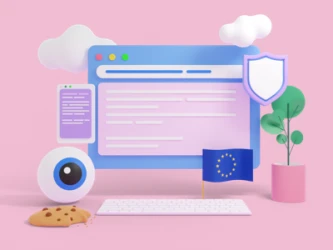We’re a Google Certified CMP Partner!
It's official, Google has recognized our CMP as one of the best in class.

Create a GDPR-ready Privacy Policy, Terms & Cookie Banner in under 5 minutes.

The GDPR is a set of laws that aim to protect the personal data of EU citizens. To comply with GDPR, websites that serve cookies must allow users to manage their cookie preferences, often presenting a prompt when a user first enters the website (a cookie popup). In this article, we will unravel the nuances of cookie popups, exploring their significance, functionality, and the best practices that pave the way for seamless GDPR cookie consent.
Scan your website cookies and create a cookie consent widget in 5 minutes.
Get StartedThe GDPR, a groundbreaking regulation implemented in 2018, is a beacon for safeguarding user privacy. Its jurisdiction extends beyond the borders of the European Union, impacting any business that processes the data of EU citizens.
Tracking Cookies are small packets of data stored on users’ devices by web browsers. These unassuming bits of code play a pivotal role in enhancing user experience by remembering preferences, login details, and other browsing information.
Cookie popups emerge as the guardians of user consent in the digital realm. Their primary purpose is to inform users about the utilization of cookies and to seek explicit permission, ensuring compliance with GDPR and other data protection regulations.
Transparent communication is the bedrock of user trust. Clearly articulate why cookies are employed and how they enhance user experience. Layman’s terms are crucial here; avoid technical jargon to ensure users comprehend the implications.
Respect user autonomy by implementing granular consent. Allow users to selectively opt-in or out of different types of cookies, such as functional, analytical, and marketing cookies. This tailored approach acknowledges diverse user preferences.
The cookie policy is the playbook for cookie usage. Ensure that a conspicuous link directs users to this comprehensive document. Detail the intricacies of data processing, instilling confidence in users about the responsible handling of their information.
Actively seek user consent before deploying cookies. Configure the system to withhold cookie placement until the user has provided clear and unambiguous consent. This aligns with the GDPR principle of opt-in rather than opt-out.
The digital landscape is ever-evolving, and so should your policies. Regularly update cookie policies to reflect changes in data processing practices or comply with new regulations. Communication is paramount; inform users of any updates to maintain transparency.
Efficiency meets compliance with third-party tools designed for GDPR cookie consent. These tools often offer customizable templates, easing the implementation process. Automated features simplify ongoing compliance efforts.
For those seeking a tailored approach, custom development of cookie popups provides flexibility. This allows websites to design interfaces that align with their unique brand identity while maintaining adherence to GDPR guidelines.
By embracing best practices and understanding the intricacies of GDPR cookie consent, businesses can forge a path through the complex web of regulations while respecting user privacy.
GetTerms can simplify the complicated task of compliance and allow you to get back to business by addressing multiple items on your compliance checklist, including tailoring your legal policy documentation and generating cookie consent banners. Please take advantage of our services today. Get started.
Scan your website cookies and create a cookie consent widget in 5 minutes.
Get Started